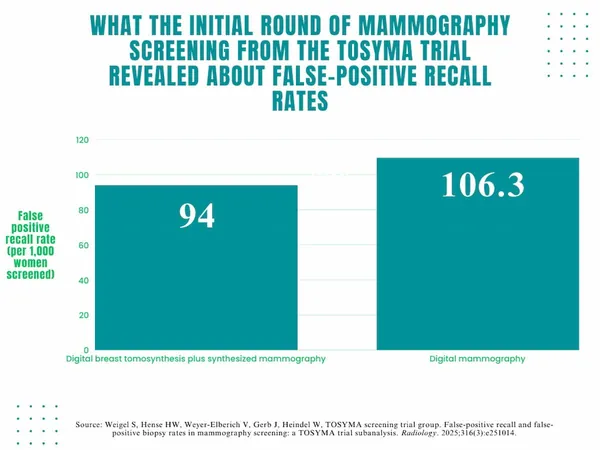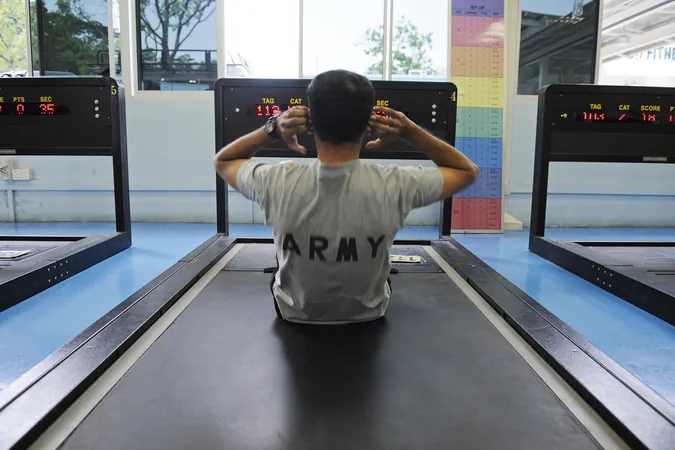
Breakthrough in Breast Cancer Screening: DBT and Synthetic Mammography Outshine Traditional Methods!
2025-09-17
Author: Mei
Recent research is shaking up the world of mammography! A groundbreaking study reveals that combining digital breast tomosynthesis (DBT) with synthetic mammography (SM) significantly enhances the accuracy of breast cancer screening.
This game-changing investigation, part of the TOmosynthesis plus SYnthesized MAmmography (TOSYMA) trial, assessed data from nearly 100,000 women. With 49,762 undergoing traditional digital mammography (DM) and 49,715 receiving the advanced DBT and SM, the analysis is making waves in the medical community.
The findings are compelling: while the overall recall rates were similar between DM and the DBT+SM combination, the latter boasted a remarkable increase in true-positive recall rates—8.4 per 1,000 women, compared to just 6.2 for DM. Moreover, the false-positive recall rate plummeted to 40.2 per 1,000 women with DBT and SM, a sharp contrast to the 43.7 in the DM group!
Notably, this trend was especially pronounced among women undergoing their first mammogram. The data revealed an astonishing reduction in false-positive recalls: 94 per 1,000 women in the DBT+SM cohort versus 109.6 in the DM group.
However, it wasn’t all smooth sailing for the DBT+SM group. Although they experienced a higher false-positive biopsy rate of 7.8 per 1,000 women compared to DM's 1.8, they also achieved a marginally better positive predictive value (PPV) for biopsies, 51.7% versus 50.6%.
Dr. Stefanie Weigel, the lead author of the study from the University of Munster in Germany, emphasized the exceptional performance of DBT and SM in terms of recall rates and cancer detection, particularly for women new to screening. She noted, "The combination not only detects more cancers but also enhances the efficiency of the screening process."
Three Key Takeaways
1. **Enhanced Cancer Detection**: DBT combined with SM substantially increases the true-positive recall rate while providing a better PPV compared to DM alone.
2. **Fewer False Positives for First-Time Screeners**: Women undergoing their first screening experienced significantly lower false-positive rates with the DBT+SM combination.
3. **Higher Biopsy PPV**: Despite a slight rise in false-positive biopsies, the superior biopsy PPV and improved overall cancer detection make DBT+SM a standout option.
In an accompanying editorial, experts Dr. Benoit Mesurolle and Dr. Mona El Khoury remarked on the unusual findings, especially concerning first-time screenings. "This is contrary to the common belief that initial screenings tend to yield higher recall rates due to lack of historical data for comparison," they said.
As for the limitations of the study, the authors pointed out that inter-reader agreement wasn’t evaluated, and comparisons made only to previous DBT exams could influence the results. The exploratory nature of some analyses means these findings are still ripe for deeper investigation.
This new evidence is a hopeful step toward more effective breast cancer screenings—could this be the future of mammography?



 Brasil (PT)
Brasil (PT)
 Canada (EN)
Canada (EN)
 Chile (ES)
Chile (ES)
 Česko (CS)
Česko (CS)
 대한민국 (KO)
대한민국 (KO)
 España (ES)
España (ES)
 France (FR)
France (FR)
 Hong Kong (EN)
Hong Kong (EN)
 Italia (IT)
Italia (IT)
 日本 (JA)
日本 (JA)
 Magyarország (HU)
Magyarország (HU)
 Norge (NO)
Norge (NO)
 Polska (PL)
Polska (PL)
 Schweiz (DE)
Schweiz (DE)
 Singapore (EN)
Singapore (EN)
 Sverige (SV)
Sverige (SV)
 Suomi (FI)
Suomi (FI)
 Türkiye (TR)
Türkiye (TR)
 الإمارات العربية المتحدة (AR)
الإمارات العربية المتحدة (AR)